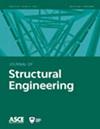What We Can and Cannot Learn from a Single Shear Test of a Very Large RC Beam
IF 3.7
3区 工程技术
Q1 CONSTRUCTION & BUILDING TECHNOLOGY
引用次数: 1
Abstract
: In the existing database on shear load capacity, tests of very large beams are scarce. Valuable additions to the database have recently been made in 2021 at the University of California, Berkeley (UCB), and in 2015 at the University of Toronto. These two tests were the largest ever among the standard three-point-bend type tests conducted so far. They verified the effects of beam size and of steel stirrups on the ultimate load, V u , provided that the same concrete and steel are used. The present analysis, which deals in detail only with the UCB test, shows that the subsequent public blind competitions to predict the V u measured in both tests were meritless and potentially misleading. The reason is that, similar to design codes, the only information provided to the competitors (besides the E modulus) was the required concrete compression strength, f 0 c , whereas the mean compressive and tensile strengths, fracture energy, initial creep data, and so on, were not provided. The fault of a competition of this kind is evidenced by (1) finite-element fracture simulations, (2) analysis of the huge statistical scatter of a database of 784 tests and a previous database in which f 0 c was also the only concrete property used, like in the design code, and (3) estimation of the statistical error due to anchoring code provisions to the classical shear strength approximation 2从超大钢筋混凝土梁的单剪试验中我们能学到什么和不能学到什么
:在现有的抗剪承载力数据库中,很少对非常大的梁进行测试。2021年,加州大学伯克利分校(UCB)和2015年,多伦多大学对数据库进行了有价值的补充。这两项测试是迄今为止进行的标准三点弯曲类型测试中规模最大的一次。他们验证了梁尺寸和钢箍筋对极限荷载Vu的影响,前提是使用相同的混凝土和钢材。目前的分析仅详细涉及UCB测试,表明随后在两次测试中预测Vu的公开盲赛是没有价值的,并且可能具有误导性。原因是,与设计规范类似,提供给竞争对手的唯一信息(除了E模量)是所需的混凝土抗压强度f 0 c,而没有提供平均抗压强度和抗拉强度、断裂能、初始蠕变数据等。(1)有限元断裂模拟,(2)分析784个测试数据库和之前的数据库的巨大统计分散,其中f0 c也是唯一使用的混凝土特性,如设计规范中所述,以及(3)估计由于锚固规范对经典抗剪强度近似值的规定而产生的统计误差,证明了这种竞争的失误
本文章由计算机程序翻译,如有差异,请以英文原文为准。
求助全文
约1分钟内获得全文
求助全文
来源期刊

Journal of Structural Engineering
工程技术-工程:土木
CiteScore
8.00
自引率
7.30%
发文量
317
审稿时长
4.5 months
期刊介绍:
One of the oldest and most respected periodicals in the field, the Journal of Structural Engineering has a history of reporting on fundamental knowledge that advances the state-of-the-art and state-of-the-practice in structural engineering. Authors discuss the art and science of structural modeling and design; develop, apply and interpret the results of novel analytical, computational and experimental simulation techniques; propose new structural systems and study the merits of existing ones; pioneer methods for maintenance, rehabilitation and monitoring of existing structures; and investigate the properties of engineering materials as related to structural behavior. Papers making a fundamental contribution in the field of structural engineering at the intersection of structural engineering and other disciplines are welcome.
 求助内容:
求助内容: 应助结果提醒方式:
应助结果提醒方式:


